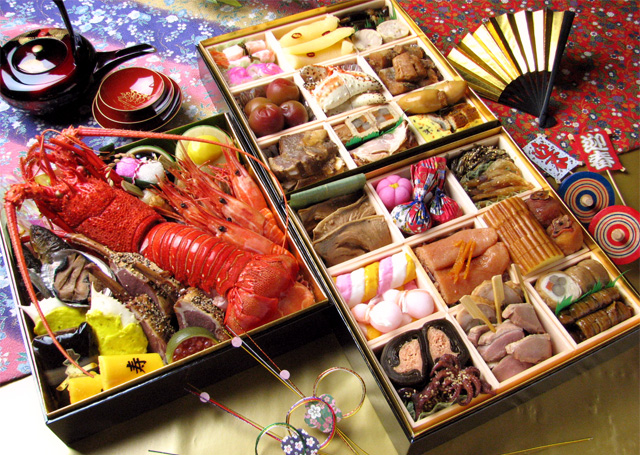Dec 26, 2024
Traditional Japanese New Years’ Foods – Osechi Ryori
Osechi-ryōri are traditional Japanese foods eaten at the start of the new year. The osechi tradition has been alive in Japan since the Heian Era (starting in 794). The foods are easily recognizable by the special bento boxes called jūbako, often stacked for larger families or parties. Like many places in Asia, food items included in Oshechi have special symbolic meanings and are generally standard.
Of course, I am sure you can find some local variations and expressions of personal taste out there; I am willing to bet there is something involving mayonnaise that is very popular. It is Japan, after all, and tradition only goes so far.
Here are some examples of dishes you might find in an osechi box at New Years’
Daidai (橙), Bitter Japanese orange. Daidai means “from generation to generation” when written in different kanji as 代々. Like kazunoko below, it symbolizes a wish for children in the New Year.
Datemaki (伊達巻 or 伊達巻き), sweet rolled omelet mixed with fish paste or mashed shrimp. They symbolize a wish for many auspicious days. On auspicious days (晴れの日, hare-no-hi), Japanese people traditionally wear fine clothing as a part of enjoying themselves. One of the meanings associated with the second kanji includes “fashionability,” derived from the illustrious dress of the samurai from Date Han.
Kuro-mame (黒豆), black soybeans. Mame also means “health,” symbolizing a wish for health in the New Year. Keep in mind these are very sweetened!
Kamaboko (蒲鉾), broiled fish cake. Traditionally, slices of red and white kamaboko are alternated in rows or arranged in a pattern. The color and shape are reminiscent of Japan’s rising sun and have a celebratory, festive meaning.
Kazunoko (数の子), herring roe. Kazu means “number,” and ko means “child.” It symbolizes a wish to be gifted with numerous children in the New Year.
Konbu (昆布), a kind of seaweed. It is associated with the word yorokobu, meaning “joy.”
Kohaku-namasu (紅白なます), literally “red-white vegetable kuai,” is made of daikon and carrot cut into thin strips and pickled in sweetened vinegar with yuzu flavor.
Tai (鯛), red sea-bream. Tai is associated with the Japanese word medetai, symbolizing an auspicious event.
Tazukuri (田作り), dried sardines cooked in soy sauce. The literal meaning of the kanji in tazukuri is “rice paddy maker,” as the fish were used historically to fertilize rice fields. The symbolism is of an abundant harvest.
Zōni (雑煮), a soup of mochi rice cakes in clear broth (in eastern Japan) or miso broth (in western Japan).
Ebi (エビ), skewered prawns cooked with sake and soy sauce.
Nishiki tamago (錦卵), egg roulade; the egg is separated before cooking, yellow symbolizing gold, and white symbolizing silver.
Depending on how much you put down for osechi, you can also find fancier items like roast beef, duck or Japanese spiny lobster. It is common to eat the osechi on the morning of January 1st along with a bowl of Zōni (usually called ozōni) and the meal signals a day of relaxation around the house.
Traditionally it was taboo to cook meals during the first three days of the New Year’s, so osechi boxes are cooked or purchased well in advance of the end of the previous year. This is a great deal of work, but it finishing this task early allows time to relax a little for the first days of the New Year. Of course, the taboo nature has lifted and plenty of people cook during the first three days now, but osechi boxes serve an important role in being available to pick at over the course of the holidays.
If you plan on buying Osechi for your family to enjoy from next year, you will find options readily available beginning as early as November. Most people order early, and you should too, if you want to get the best! Alternatively, you could make something at home.
Making Osechi
Here are a few varieties to get you started.
Osechi Kuromame, or Black Beans
Osechi Kurikinton, or Mashed Sweet Potatoes
Tamagoyaki, or Fried Eggs
Osechi Zōni, or White Miso Soup with Mochi Cake
Osechi Tazukuri, or Dried Sardines with Soy Sauce
– No machine-readable author provided. “Oseti” [GFDL, CC-BY-SA-3.0 or CC BY-SA 2.5-2.0-1.0], via Wikimedia Commons -Modified


About the author